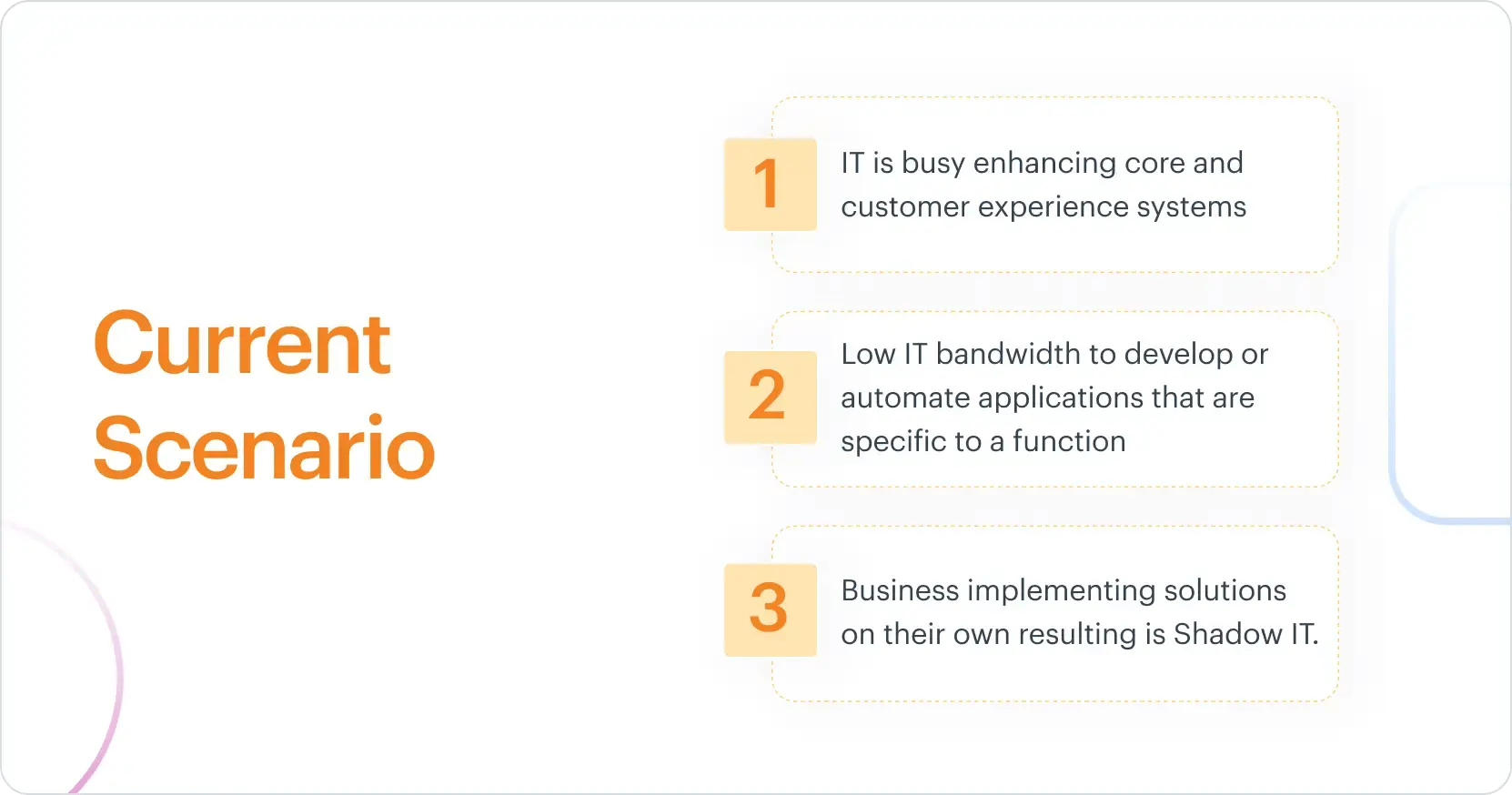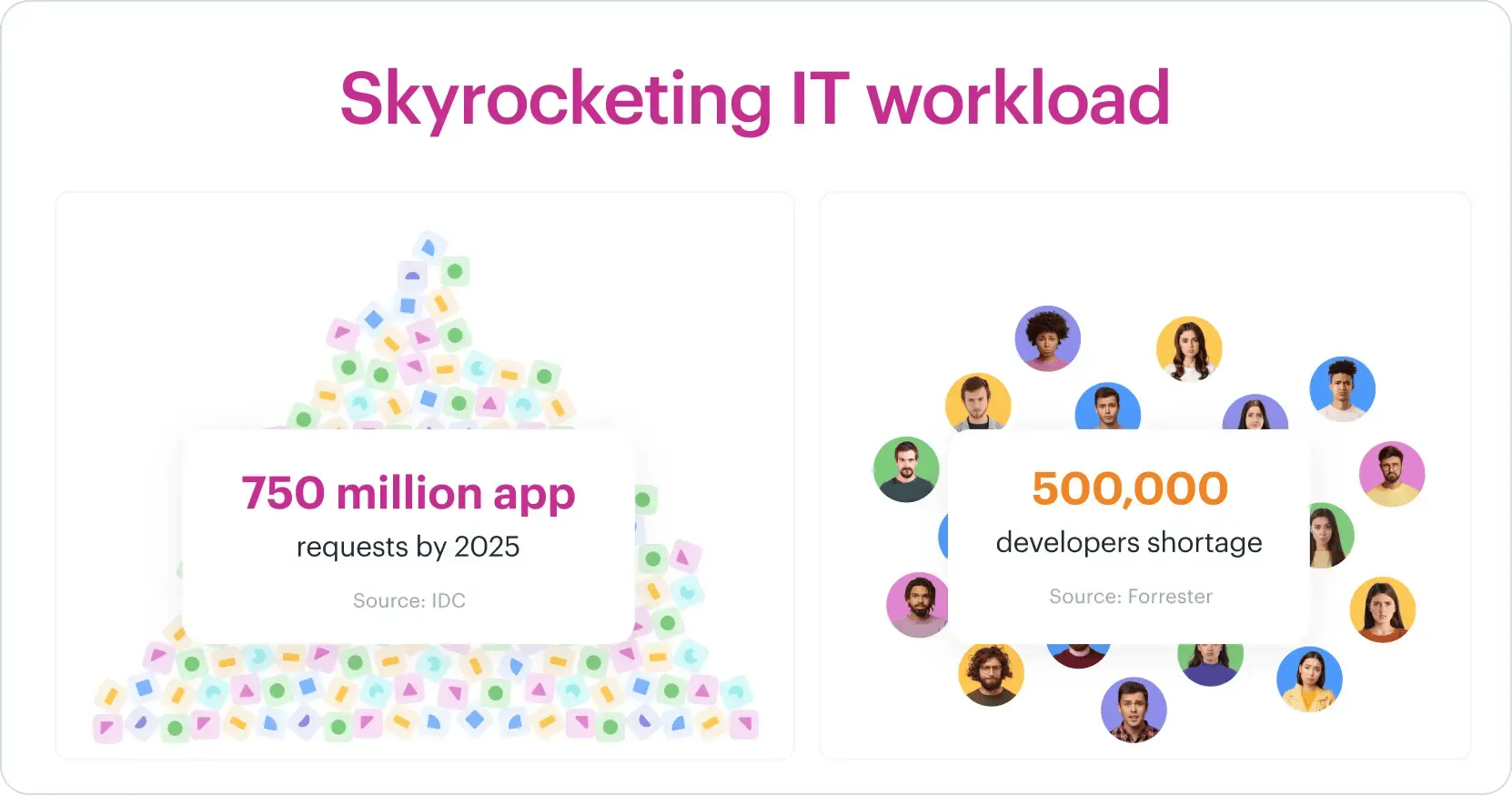There's a lot of talk about citizen development and using low-code platforms. But for many tech leaders, it's all a bit unclear. If you are an IT leader, you’re probably wondering why you should bother with these platforms and how they fit into your tech ecosystem
Low-code/no-code platforms facilitate collaboration between IT and business teams, enabling non-IT teams to participate in app development, encouraging innovation and organizational transformation.
In this chapter, these questions are addressed head-on. It delves into citizen development's intricacies, covering its benefits and challenges. By the end, you will gain a clear understanding of how citizen development fosters innovation in organizations.
1. Why should tech leaders consider low-code platforms for citizen development?
Tech leaders should consider low-code platforms for citizen development because they help bridge the gap between business and IT teams, promoting cooperation and innovation.
Alignment between IT and business contributes to citizen development by ensuring that the chosen low-code platform strikes the right balance between developer-friendly features and simplicity for citizen developers. It also offers a common playground where IT professionals and citizen developers can work together effectively.
These platforms allow non-IT teams with varying technical expertise to contribute to application development using intuitive interfaces and templates, ensuring that solutions align with business goals.
Low-code platforms also meet the security standards demanded by IT, thus providing a conducive environment for citizen development while addressing IT concerns.
These platforms reduce shadow IT risks by providing a secure, controlled environment. Shadow IT arises from unauthorized tools, compromising security and compliance. With low-code platforms, tech leaders offer an approved alternative, allowing employees to innovate while maintaining IT governance and security.

2. Why citizen development now?
A recent survey on the State of Internal Application development by Kissflow inferred that 88 percent of business leaders agree that democratizing technology drives innovation and success, and 40 percent of business applications are built internally, strengthening internal app development helps businesses gain a competitive edge.
Additionally, 64 percent of tech leaders believe that low-code platforms can tackle major app development challenges, and 28 percent rely on low-code to scale and automate their approach.
Organizations can empower employees to contribute to innovation by democratizing technology through citizen development and embracing low-code platforms. This approach fosters a culture of creativity and enables businesses to address critical app development needs while staying ahead in today's competitive landscape.
With projections indicating 750 million app requests by 2025 and a shortage of 500,000 developers, there's a pressing need for citizen developers to sustain this rate of innovation. Low-code platforms help organizations meet these demands efficiently, highlighting the critical role of citizen developers in modern business environments.

Learn about the citizen development program
3. How do I identify citizen developers in my organization?
Look for individuals who exhibit the following characteristics:
-
Technical enthusiasm
They are excited about leveraging technology to solve business challenges and eager to explore new solutions.
-
Curiosity and eagerness to learn
They constantly seek opportunities to expand their knowledge and skills, asking insightful questions and actively pursuing learning opportunities.
-
Desire for upskilling
They view building applications as a chance to enhance their capabilities and willingly invest time and effort into learning new skills.
-
Systems thinking
They can anticipate how different systems interact with each other, making plans to address potential risks and capitalize on opportunities.
-
Commitment to continuous improvement
Once their applications are live, they consistently seek ways to enhance and optimize their creations, striving for ongoing improvement.
-
Collaborative mindset
They recognize that application development is a collaborative endeavor and are open to sharing knowledge, listening to feedback, and adapting their approaches based on input from others.
-
Quick learning abilities
They demonstrate a knack for quickly grasping new concepts and patterns, enabling them to experiment and explore new skills independently.
Identifying individuals with these traits can help you identify potential citizen developers who are equipped to contribute effectively to application development initiatives within your organization.
How do you identify a citizen developer?
4. Why are citizen developers important for driving innovation in today's businesses?
Citizen developers play a crucial role in boosting innovation and agility in modern businesses because they bring domain expertise and firsthand knowledge of business needs. Their involvement accelerates the development process, enabling rapid iteration and adaptation to changing requirements. This allows businesses to respond quickly to market demands, experiment with new ideas, and stay ahead of the competition.

5. What are some of the real-world challenges that citizen developers can solve?
Citizen developers can tackle various real-world challenges across different industries and departments. Some common challenges they can address include:
- Streamlining business processes through automation and workflow optimization.
- Addressing departmental needs with tailored applications.
- Enhancing customer/employee experience with self-service portals and mobile apps.
- Improving data management with dashboards and reporting tools.
How to capitalize on citizen development?
6. What are the challenges involved in citizen development?
Although citizen development presents many benefits, failing to address its accompanying challenges may exacerbate issues rather than resolve them. Some of the common challenges are:
-
Security
Citizen developers may lack the expertise to implement robust security measures, leading to potential data breaches and compliance violations.
-
App quality
Inexperienced developers may create applications with subpar quality, resulting in crashes, poor user experience, and data inaccuracies.
-
Limited systems thinking
Business users may not consider the broader system implications of their applications, leading to data silos, inefficiencies, and user frustration.
-
Key person dependency
Relying too heavily on a single enthusiastic citizen developer can pose risks if that individual leaves the organization or is unavailable.
-
Compliance and regulations
Citizen developers may inadvertently create applications that fail to comply with industry regulations and legal requirements, exposing the organization to legal consequences
.
-
Decentralization
Ungoverned citizen development can lead to a proliferation of applications across departments, causing coordination and standardization challenges.















